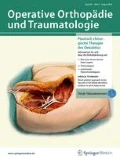Zusammenfassung
Operationsziel
Wiederherstellung oder Erhaltung der Belastungsfähigkeit des Kniegelenks. Verzögerung der Entwicklung einer Gonarthrose.
Indikationen
Ausgedehnte Knorpel-Knochen-Läsionen in der Belastungszone des Femurkondylus.
Achsenabweichungen und Bandinstabilitäten sollten vor oder idealerweise zeitgleich im Rahmen der Mega-OATS-Operation korrigiert werden.
Kontraindikationen
Nicht lokalisierte Knorpel-Knochen-Läsionen.
Pangonarthrose.
Akute und chronische Arthritis oder Infektion des Kniegelenks.
Chondrokalzinose.
Nicht korrigierbare Achsenfehlstellungen oder Bandinstabilitäten.
Biologisches Alter jenseits des 55. Lebensjahrs.
Postoperative Aktivitäten mit hohen Belastungen in starker Kniebeugestellung (z.B. Plattenleger, Skirennläufer).
Operationstechnik
Anteromediale oder anterolaterale Arthrotomie. Darstellung und Ausmessen des betroffenen Knorpel-Knochen-Areals. Ausfräsen des Defekts bis zum Erhalt eines vitalen Transplantatbetts. Tiefenmessung des präparierten Defekts. Entnahme des medialen posterioren Femurkondylus. Vorbereitung des Transplantatzylinders aus dem entnommenen posterioren Femurkondylus in einer speziellen Mega-OATS-Workstation (Zylinderdurchmesser zwischen 20 und 35 mm). Einbringen des Mega-OATS-Zylinders in Pressfit-Technik.
Weiterbehandlung
Initial Motorschienenbehandlung, aktive Beweglichkeit 90°-0°-0° und Entlastung an Unteramgehstützen für 6 Wochen postoperativ, danach progressiver Belastungsaufbau mit 20 kg pro Woche bis zur Vollbelastung bei freier aktiver Beweglichkeit. Vier-Punkt-Hartrahmenorthese für 6 Wochen. Begleitendes intensives Muskelaufbau- und propriozeptives Training vom 3. bis 6. Monat, sportartspezifisches Training ab dem 7. Monat.
Ergebnisse
Die ersten Patienten nach Mega-OATS-Transplantation mit einem großen osteochondralen Defekt von 6 cm2(4–9 cm2) am Femurkondylus konnten durchschnittlich 12 Monate (17 Patienten) und 55 Monate (16 Patienten) postoperativ sowohl klinisch als auch radiologisch nachkontrolliert werden. Hierbei wurde eine signifikante Steigerung im Lysholm-Score von präoperativ 62 ± 4 Punkten (Mittelwert ± Standardfehler) auf 85 ± 7 Punkte nach 12 Monaten bzw. 81 ± 4 Punkte nach 55 Monaten beobachtet. Bei neun Patienten wurde aufgrund einer Varusfehlstellung eine kombinierte hohe tibiale Umstellungsosteotomie durchgeführt, wobei keine signifikante Differerenz im Lysholm-Score zwischen der Untergruppe mit oder ohne gleichzeitige tibiale Umstellungsosteotomie feststellbar war. Subjektiv waren über 90% der Patienten zufrieden. In randomisierten Kernspintomogrammen ließen sich eine gute Vitalität des Mega-OATS-Zylinders und ein unauffälliges ipsilaterales Meniskushinterhorn nachweisen.
Abstract
Objective
Restoration or preservation of the loading tolerance of the knee joint. Delay of the development of degenerative arthrosis.
Indications
Extensive osteochondral defects (traumatic, posttraumatic, osteochondrosis dissecans, focal osteochondronecrosis) within the weight-bearing zone of the femoral condyle.
Comorbidities such as malalignment and ligament instabilities should be addressed prior to or, ideally, simultaneously with the Mega-OATS intervention.
Contraindications
Delocalized uni- and multicompartmental osteochondral lesions of the knee.
Tricompartmental knee arthrosis.
Acute and chronic arthritis or infection of the knee.
Chondrocalcinosis.
Not simultaneously corrected or noncorrectable malalignment or ligamentous instabilities.
Patient’s age > 55 years.
Postoperative continuation of activities with high loading stresses at high knee flexion angles, e.g. pavior, downhill ski racer.
Surgical Technique
Anteromedial or anterolateral arthrotomy. Exposure and measurement of the affected osteochondral area. Reaming of the defect until attainment of a vital bed of the defect. Measurement of the depths of the prepared defect. Removal of the medial posterior femoral condyle. Preparation of the cylinder of the transplant harvested from the removed posterior femoral condyle using a specially designed Mega-OATS workstation (diameter between 20 and 35 mm). Placement of the Mega-OATS cylinder in press-fit technique.
Postoperative Management
Initial continuous passive motion therapy, active range of motion 90°-0°-0°, and unloading for 6 weeks postoperatively using crutches, followed by progressive weight bearing with 20 kg per week until full weight bearing. Free active range of motion as tolerated from 7th week. Four-point hard-frame knee orthosis for 6 weeks. Concomitant intensive muscle and proprioceptive training from 3rd to 6th month. Specific sports rehabilitation program starting 7th month.
Results
The initial 17 and 16 patients following Mega-OATS procedure due to a large osteochondral defect (average size 6 cm2, range 4–9 cm2) of the femoral condyle were clinically examined including an image-guided evaluation protocol at an average follow-up of 12 and 55 months, respectively. In the Lysholm Score, there was a significant increase from 62 ± 4 points (mean ± SEM [standard error of the mean]) preoperatively to 85 ± 7 points at 12 months and 81 ± 4 points at 55 months postoperatively. In nine patients with varus malalignment, a simultaneous high tibial osteotomy was performed. However, a significant difference in the Lysholm Score between the subgroup with and without simultaneous high tibial osteotomy could not be found. In more than 90% of the patients, a high subjective satisfaction rate was noted. Randomized magnetic resonance images revealed a good viability of the Mega-OATS graft as well as an intact posterior horn of the ipsilateral meniscus.
Author information
Authors and Affiliations
Corresponding author
Rights and permissions
About this article
Cite this article
Brucker, P.U., Braun, S. & Imhoff, A.B. Mega-OATS-Technik – autogene Knorpel-Knochen-Transplantation als Salvage-Verfahren bei großen osteochondralen Defekten am Femurkondylus. Orthop Traumatol 20, 188–198 (2008). https://doi.org/10.1007/s00064-008-1301-3
Published:
Issue Date:
DOI: https://doi.org/10.1007/s00064-008-1301-3
Schlüsselwörter
- Osteochondraler Defekt
- Osteochondrosis dissecans
- Fokale Osteonekrose
- Autogene Knorpel-Knochen-Transplantation
- Mega-OATS

